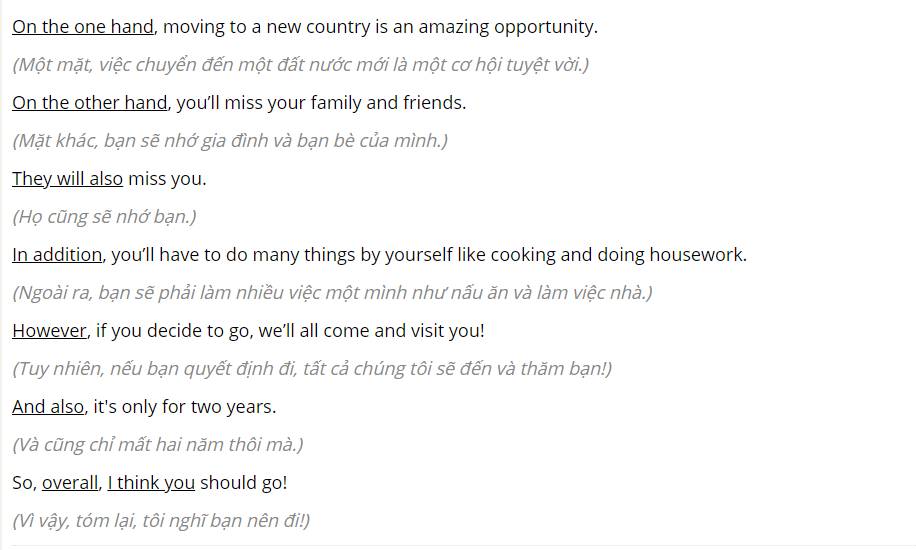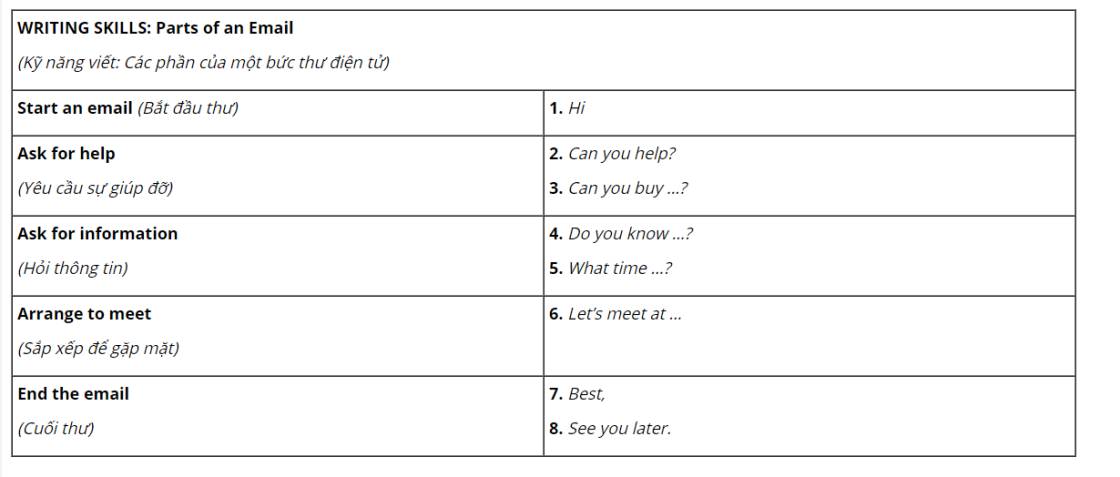Hãy nhập câu hỏi của bạn vào đây, nếu là tài khoản VIP, bạn sẽ được ưu tiên trả lời.

1. send a photo to your grandparents: informal writing
(gửi một bức ảnh cho ông bà của bạn: văn phong thông thường)
2. apply for a scholarship: formal writing
(xin học bổng: văn phong trang trọng)
3. keep in touch with friends from Brazil: informal writing
(giữ liên lạc với bạn bè từ Brazil: văn phong thông thường)
4. send an assignment to your teacher: formal writing
(gửi bài tập cho giáo viên: văn phong trang trọng)
5. invite a friend out tonight: informal writing
(mời một người bạn đi chơi tối nay: văn phong thông thường)

- Human and animal (Con người / Động vật)
+ similarity: communicate by touching
(giống nhau: giao tiếp bằng cách chạm vào nhau)
+ difference: animals can’t speak languages, people can speak languages
(khác nhau: động vật không thể nói ngôn ngữ, nhưng con người có thể nói ngôn ngữ)
- Speaking / Writing (Nói / Viết)
+ similarity: both use languages
(giống nhau: cả hai đều dùng ngôn ngữ)
+ difference: emotion is far easier to interpret from speaking than in writing
(khác nhau: cảm xúc được truyền tải qua lời nói dễ hơn là viết)
- Face-to-face / Electronic (Mặt đối mặt / Thiết bị điện tử)
+ similarity: both communication ways limit the number of people a person can interact with
(giống nhau: cả hai cách giao tiếp đều giới hạn về số lượng người mà một người có thể tương tác)
+ difference: a person can use body language in face-to-face communication; however, one cannot use body language in the written way of online communication
(khác nhau: một người có thể sử dụng ngôn ngữ cơ thể trong giao tiếp mặt đối mặt; tuy nhiên, người ta không thể sử dụng ngôn ngữ cơ thể trong giao tiếp trực tuyến bằng văn bản)
- Social media / Text (Mạng xã hội / Văn bản)
+ similarity: both types can reach massive audiences
(giống nhau: cả hai loại đều có thể tiếp cận đến một lượng khán giả lớn)
+ difference: social media lets people communicate in two-way. It means unlike text, social media users can leave reactions, comments, etc.
(khác nhau: mạng xã hội cho phép mọi người giao tiếp hai chiều. Không giống như văn bản, người dùng mạng xã hội có thể để lại phản ứng, bình luận, v.v.)

Dear Sir or Madam,
(1) On Friday, November 27th, I bought a Link76 laptop from your website and it is not working.
The laptop has two main problems. (2) It overheats when I play games and it keeps crashing when I do my homework. It also sometimes slows down when I watch movies.
(3) I called RocketTech's customer hotline and waited 30 minutes to speak to someone. Finally, I spoke to your colleague, Andy. He said he would speak to his manager and call back in ten minutes. That was three hours ago.
(4) I would like RocketTech to repair my laptop or provide a new one as soon as possible.
I look forward to your reply.
Yours faithfully,
June Evans

- This person is writing to the friend who has won the scholarship.
(Người này viết thư cho người bạn mà giành được học bổng.)





1 - a
2 - d
3 - b
4 - e
5 - c